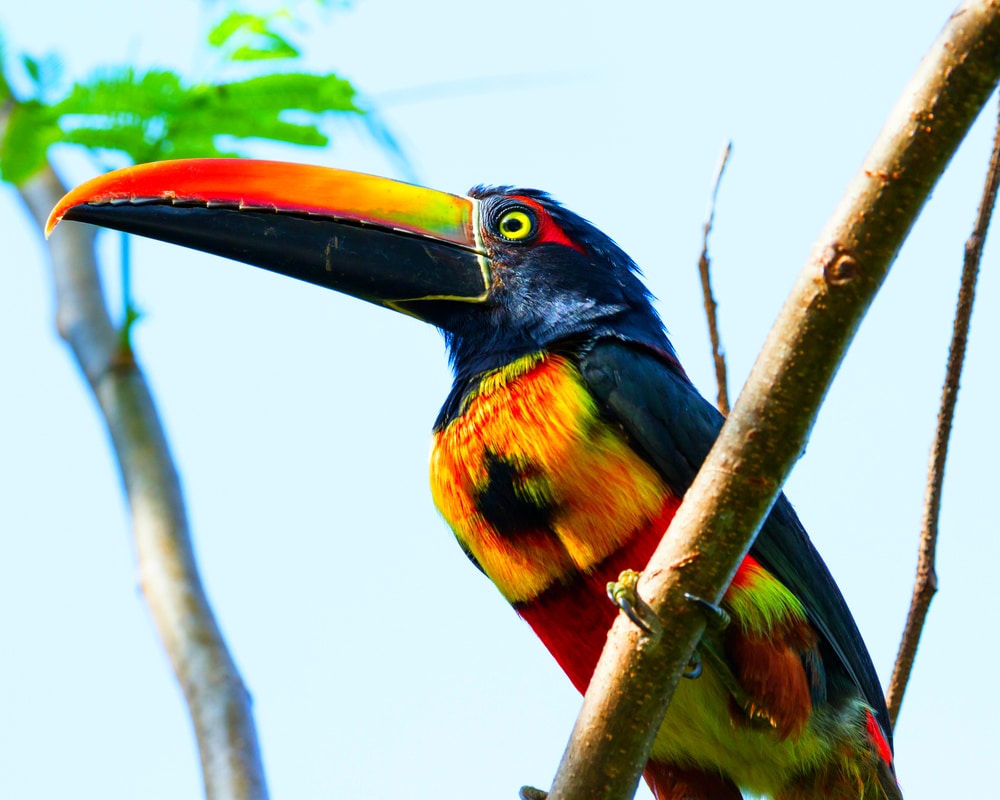Costa Rica is home to one of the most beautiful toucans in the world- the Fiery-billed Aracari.
Costa Rica is a bird watcher’s paradise with nearly 900 species, but even if you’re only a casual birder, you almost can’t help catching sight of the Fiery-billed Araçari (ARA-sah-ri) when you’re on vacation on the Pacific coast of this beautiful country.
Part of the toucan family, the Fiery-billed Araçari roosts socially year-round, in groups of up to 10 birds. You can easily identify its large, distinctively shaped bright orange-red upper beak. The massive beak’s hollow structure makes it lighter than it looks.
Adult males and females look alike, while juveniles are duller in color. An adult is about 20 inches long and weighs about 9 ounces. Look for a bright red band on a brilliant yellow chest with glossy black feathers of its back and neck. Its rump also sports yellow and red feathers, while its yellow eye stands out against its black-olive head. The Fiery-billed Araçari has a dark spot on a field of yellow, just above the red band across its breast that its close cousin, the collared araçari (which also has a thin rufous collar on the back of its neck), doesn’t have.
Although mostly tree-dwellers that eat fleshy fruits found in the canopy, the Fiery-billed Araçari will sometimes descend to the forest floor for berries. Because it passes the seeds undamaged, the Fiery-billed Araçari contributes to biodiversity. It will also eat insects and, sometimes, small pigeon or woodpecker nestlings.
Fiery-billed Araçaris will often evict woodpeckers and nest in their treetop cavities 20 feet and higher in the canopy, where they lay two white eggs that hatch after about 16 days. The parents share incubation and chick-rearing duties and often continue to feed young fledglings with occasional help from other araçaris. Fiery-billed and Collared Araçari interbreed occasionally.
You can find Fiery-billed Araçaris in humid lowland forests along the Pacific slopes of southern Costa Rica, to an elevation of about 6,000 feet. They’re pretty common from Herradura, down the Costa Rica Pacific coast, and on into western Panama. Sadly, their numbers may be declining; formerly you could also find them in eastern Panama and on close, offshore islands.
If you ’re staying at the distinctive Hotel Villa Caletas, you’re bound to spot them aplenty in the surrounding trees, as you lounge on your jungle surrounded balcony, enjoy pool time, or sunset drinks and bocas the Anfitreato Bar Restaurant.
In flight, Fiery-billed Araçari makes a sharp, two-noted call that sounds similar to pseek or keeseek. Between the sound of their call and the brilliantly flashing plumage, you’ll have no trouble spotting a fiery-billed araçari in the forest while you’re on vacation in Costa Rica.


